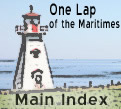Return to alavigne.net home
 Introduction
New England Shortcut
The Evangeline Trail
Cape Split and Cape Breton
Nova Scotia's Highpoint
The Cabot Trail
Prince Edward Island
A Tale of Two Visits
Family Business
Introduction
New England Shortcut
The Evangeline Trail
Cape Split and Cape Breton
Nova Scotia's Highpoint
The Cabot Trail
Prince Edward Island
A Tale of Two Visits
Family Business
 In-depth: The Hancocks Hike
In-depth: The Cape Split Hike
In-depth: White Hill Climb (NS Highpoint)
In-depth: The PEI Highpoint
In-depth: The Hancocks Hike
In-depth: The Cape Split Hike
In-depth: White Hill Climb (NS Highpoint)
In-depth: The PEI Highpoint
Maritimes 2008
Main Page
 Introduction
New England Shortcut
The Evangeline Trail
Cape Split and Cape Breton
Nova Scotia's Highpoint
The Cabot Trail
Prince Edward Island
A Tale of Two Visits
Family Business
Introduction
New England Shortcut
The Evangeline Trail
Cape Split and Cape Breton
Nova Scotia's Highpoint
The Cabot Trail
Prince Edward Island
A Tale of Two Visits
Family Business
 In-depth: The Hancocks Hike
In-depth: The Cape Split Hike
In-depth: White Hill Climb (NS Highpoint)
In-depth: The PEI Highpoint
In-depth: The Hancocks Hike
In-depth: The Cape Split Hike
In-depth: White Hill Climb (NS Highpoint)
In-depth: The PEI Highpoint
Web Page & Design Copyright 2001-2025 by Andrew Lavigne. (Privacy Policy)
